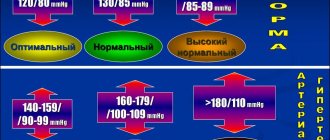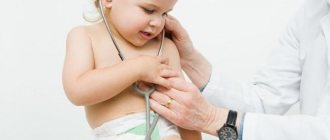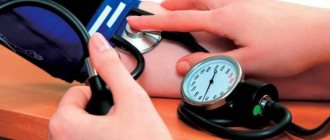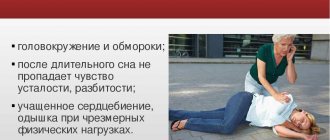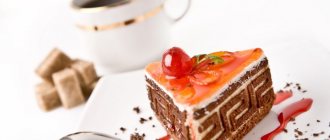Recently, pediatricians are increasingly faced with hypertension in children. The standard indicators of the tonometer depend on the gender, height and age of the patient.
The measurement technique also influences the diagnostic result. For example, in a supine position, the systolic value is slightly higher and the diastolic value is lower than in a standing position.
Why high blood pressure occurs in a child, who is at risk, the main symptoms of the disease, features of its treatment and prevention - the article will tell you about all this.
Causes of high blood pressure in a child
Pressure changes are often observed in boys from 11 to 13 and in girls from 10 to 12 years. This is explained by the physiological characteristics of the body during puberty.
In adolescence, it is permissible to increase systolic values to 120 mmHg. But it happens that during this period the tonometer shows too high numbers.
The causes of hypertension in childhood can be:
- lack of rest;
- lack of sleep;
- excessive physical activity;
- psychological stress;
- stress;
- excess body weight.
As you get older, your blood pressure usually normalizes.
But parents are still advised to take their child to the doctor, since hypertension can cause serious illness. For example:
- kidney pathologies;
- brain damage;
- poisoning;
- disturbances of vascular tone;
- endocrine diseases.
In children under 6 years of age, hypertension often develops due to stenosis and thrombosis of the renal arteries, bronchopulmonary dysplasia, renal malformation, and coarctation of the aorta. In adolescents, dangerous factors include kidney pathologies, adult-type coarctation of the aorta, and metabolic syndrome. In these cases, a secondary form of hypertension is observed.
It is important for parents to protect their children from situations that provoke an increase in blood pressure readings. It is also necessary to monitor your health and periodically measure your blood pressure.
What can cause high blood pressure?
If high blood pressure appears regularly in teenagers for no reason, this should not be ignored; you must consult a doctor and begin treatment. The disease can cause complications in the form of:
- ischemic disease,
- stroke,
- heart attack,
- hypertension.
If you ignore the increase in blood pressure, by the age of 22-25, problems with the heart may begin, requiring serious treatment and medical supervision.
A regular increase in blood pressure indicates adolescence. To prevent childhood hypertension from developing further, you need to consult your doctor and undergo a course of therapy.
See also How red wine affects blood pressure: increases or decreases
Risk group
Hypertension increases the likelihood of a dangerous heart attack or stroke. Children who are at risk are more likely than others to develop problems with blood pressure.
It is worth noting that many risk factors can be successfully controlled and significantly reduced. It is enough to change your lifestyle and regularly carry out the prevention of pathology.
According to statistics, boys are more susceptible to hypertension than girls. Children at risk include:
- with excess body weight;
- who eat incorrectly (salty foods predominate in the diet);
- leading an inactive lifestyle;
- premature;
- those born in late and difficult labor;
- taking medications whose list of side effects includes hypertension;
- born from mixed marriages. Such children are susceptible to juvenile forms of hypertension;
- with heart disease, renal pathologies, hormonal disorders;
- at least one of whose parents suffered from high blood pressure. If only the mother or father is sick, the risk of inheriting the pathology by the offspring is 30%; if both parents are hypertensive, then the probability increases to 50%.
The health of a baby who is at risk must be constantly monitored. It is recommended to regularly visit a pediatrician for a preventive examination and diagnosis of pathology at the initial stage.
What you need to remember (video)
- Hypertension can be primary or secondary. The first arises from behavioral characteristics, unhealthy lifestyle and current diseases, the second is caused by chronic diseases.
- Common symptoms of high blood pressure include irritability, confusion, arrhythmia, shortness of breath, heart pain, lethargy, dizziness, and headaches.
- Buy and use a blood pressure monitor regularly. If your blood pressure does not go down within a few days, consult your doctor.
Symptoms of hypertension
In infants, a common sign of hypertension is shortness of breath, which worsens during lactation. There is also a slight weight gain and developmental delay.
In children, as a rule, high blood pressure does not show painful symptoms. Preschoolers and schoolchildren who have hypertension often complain of feeling unwell.
As a rule, the following signs are present when hypertension develops:
- drowsiness;
- dizziness;
- headache;
- nausea;
- hand trembling;
- nosebleeds;
- vomit;
- decreased clarity of vision;
- deterioration in memorization of new material.
Children with high blood pressure are subject to frequent mood swings, are easily irritated, and can be aggressive or whiny.
During a general examination, the doctor notes the following symptoms:
- tachycardia;
- moon-shaped face;
- coffee-milk shade of the skin;
- there are wing-shaped folds on the neck;
- skin warm and moist;
- strengthening tendon reflexes.
Systemic examination shows the following signs of hypertension:
- epigastric murmurs;
- altered retinal arteries
- murmurs in the costovertebral angle
- volumetric formations in the abdominal area.
The disease in its advanced form can cause severe complications. Therefore, if the above symptoms of hypertension are repeated frequently, you should contact your pediatrician and undergo treatment.
How to detect high blood pressure in a timely manner?
Almost always, high blood pressure in a teenage child is detected by chance during a doctor’s examination for the purpose of disease prevention. Parents of the child should be attentive to complaints:
- headache;
- sleep problems;
- pale skin;
- dizziness;
- imbalance;
- weakness;
- heart pain;
- increased sweating;
- blood from the nose;
- gagging.
If several symptoms of hypertension in a teenager have been identified, blood pressure should be measured regularly. If there is repeated enlargement, you should consult a doctor who will determine the diagnosis and prescribe treatment based on the data:
- medical history;
- level of physical activity;
- CBC (general blood test), UAM (general urinalysis);
- conditions at home, at school, in sections;
- nutrition (if the child is obese).
The doctor measures blood pressure in the patient’s arms and legs. Before performing the procedure, it is necessary for the patient to be in a calm state for 15 minutes.
See also What to do if your pulse and blood pressure are high?
Diagnostics
For accurate diagnosis, it is necessary to correctly determine pressure readings.
It is not always possible to detect deviations from the norm with a one-time measurement in a doctor’s office or at home. Pediatricians use the ABPM method, the essence of which is daily monitoring.
It should be taken into account that children sometimes experience “white coat” hypertension: the pressure rises only when it is measured by a doctor. The reason is emotionality: many kids are afraid of doctors and the procedures performed by doctors.
Outwardly, the child may appear calm (not screaming or crying), but the internal experience will be strong. A similar phenomenon is observed in 20% of children. The pediatrician must take this fact into account.
There is also an invasive research method.
It is characterized by traumaticity and pain.
But at the same time it is the most accurate. The idea is that a needle with a pressure gauge is inserted into the vessel, which directly measures the pressure in the blood.
For diagnostics at home, special tonometers (mechanical and electronic) are used. The Korotkoff method is also used. This method is sensitive to many factors.
The results obtained depend on the width and length of the cuff. The doctor has a set of cuffs in his office that are used for children of different ages.
To monitor the baby’s condition, parents are advised to purchase a home blood pressure monitor. It is better to give preference to mechanical devices: they are more accurate.
To obtain the most accurate data, you need to measure pressure with a tonometer in comfortable conditions, after a five-minute rest, in a sitting position. Measurements are taken twice: on the right and left hand. The larger number is taken into account.
Drug treatment
When treating hypertension, it is not necessary to use medications. They are used only in the later stages of pathology, when lifestyle changes and diet do not help normalize blood pressure.
Often, inhibitory medications that constrict blood vessels are used to treat high blood pressure. It is thanks to the vasoconstrictor effect that the blood pressure of patients decreases. Even people with heart failure or diabetes can use inhibitors.
How to treat?
High blood pressure is not a primary disease, but a manifestation of pathology. Therefore, it is necessary to treat the disease that provoked the high tonometer numbers.
You can take pills that eliminate the symptoms of hypertension. But their effect does not last long. In this case, the existing disease will progress.
For vegetative-vascular dystonia of the hypertensive type, children are prescribed sedative therapy with drugs:
- Bromine with valerian;
- Seduxen;
- Elenium.
In parallel with taking the pills, it is recommended to normalize the daily routine: walk more with the baby in the fresh air, give moderate physical and mental stress.
If only systolic pressure increases, then pediatricians prescribe beta-blockers - Obzidan, Inderal. Taking these medications reduces systolic output and decreases blood pressure monitor readings.
With elevated systolic and diastolic values, doctors prescribe:
- Raunatin;
- Rauvazan;
- Reserpine.
Raunatin tablets
Recently, hypertension in children has been treated with calcium channel blockers (Cordarone, Nifedipine), angiotensin II inhibitors (Captopril, Capoten). The last group of medications is indicated for pathologies of renal origin.
Drug treatment is carried out for the second and third types of hypertension. For mild symptoms, it is better to use herbal decoctions and infusions. Sometimes it is enough to change your lifestyle to normalize the condition.
The dosage of each drug is selected individually. In this case, the patient’s condition and sensitivity to the active ingredients of the drug are taken into account.
What to do and how to treat high blood pressure?
If high blood pressure in a teenager or younger child is a symptom of any internal disease, then treatment should first of all be aimed at eliminating the root cause of the pathology. If blood pressure is persistently elevated, blood pressure medications must be prescribed. If hypertension is a consequence of vegetative-vascular dystonia, it is recommended to give the child Elenium, Seduxen tablets or valerian tincture, strictly observing the dosages agreed with the doctor.
Another effective medicine for blood pressure for children is Reserpine. The drug is taken after meals, depending on the severity of hypertension, the drug is drunk 2-4 times a day. You can quickly lower blood pressure if you give your child one of the suggested remedies:
High levels quickly normalize after taking Cordarone.
- "Cordaron";
- "Nifedipine";
- "Captopril."
Diuretics are often prescribed to reduce blood pressure, which remove excess fluid from the body. Medicines that have proven themselves to be effective:
- "Veroshpiron";
- "Aldosterone".
To reduce blood pressure in a teenager, medications alone will not be enough. It is also important to improve your diet, normalize body weight if necessary, and give up fast food, chips, crackers, sweet soda and store-bought juices. Baby food must be completely balanced, so the specific diet and indicative menu must be agreed upon with a nutritionist and cardiologist.
Folk remedies
Red rowan juice prepared according to this recipe helps normalize blood pressure levels:
- Sort the fruits, remove debris, rinse well and pass through a juicer.
- Freshly squeezed juice in the amount of 1 tbsp. l. give to the child during the day every time before the main meal.
With this pathology, young patients can drink beet juice.
Beetroot juice treats childhood hypertension. To prepare it, you need to grate the root vegetable on a fine grater, squeeze the resulting cake through cheesecloth. Combine the liquid with honey in equal proportions, take a spoonful morning and evening before eating. This tasty mixture will help enrich the body with vitamins and beneficial elements:
- Grind 200 g of dried apricots, prunes, raisins, figs and walnuts in a meat grinder.
- Combine the ingredients and mix well.
- Add 1 tbsp to the finished mixture. liquid honey, mix again.
- The finished product is consumed in a tablespoon 3-4 times a day. The medicine should be stored in the refrigerator.
ethnoscience
There are many proprietary methods that are aimed at getting rid of the disease without pharmaceutical drugs.
The method of Strelnikov I.V. is popular on the Internet. Cardiologists are skeptical about this treatment.
The breathing exercises of Strelnikova A.N. are highly respected. According to parents' reviews, the first five exercises are especially effective: Pump, Palms, Cat, Shoulders, Hug your shoulders.
During one lesson, the child takes about 500 breaths and movements that train the cardiovascular system. Traditional medicine offers treatment for high blood pressure with plain water. To do this, you need to take the liquid into a glass in the evening and place it near the bed.
In the morning, when you wake up, stretch and massage your head. Then pour water from one container to another 30 times, holding both high above your head. Then drink the contents of the vessel in small sips. This procedure is repeated daily for a month.
There are many more unconventional ways to combat hypertension on the Internet. But their effectiveness is questionable. Therefore, it is better to seek help from pediatricians who will select an effective treatment regimen.
Prevention measures
Prevention of high blood pressure consists of proper diet and daily routine.
It is useful to play sports. Prolonged sleep is indicated. If you are overweight, you need to lose it.
A child who is at risk should undergo regular preventive examinations.
It is also recommended to send children to sanatoriums and rest homes, where physiotherapeutic procedures and drug treatment are carried out.


